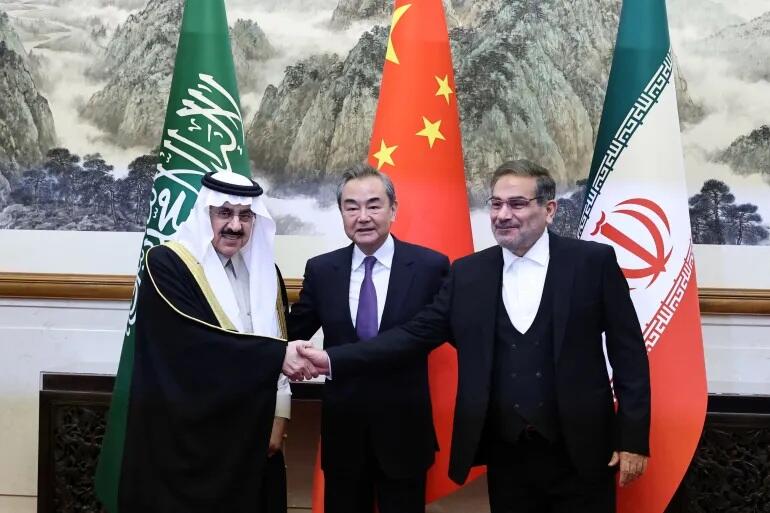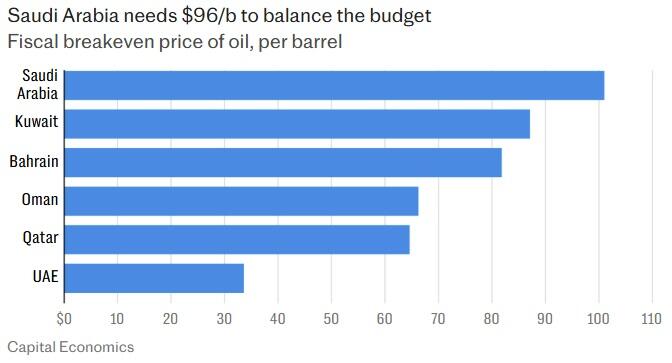Update(1920ET): Trump's Gulf tour which so far has emphasized deal-making and 'no more chaos' in the Middle East, looks to be resonating with Tehran, whose leadership is closely following from just across the Persian Gulf.
In a major breaking report, NBC says that "Iran is ready to sign a nuclear deal with certain conditions with President Donald Trump in exchange for lifting economic sanctions, a top advisor to Iran’s supreme leader told NBC News on Wednesday."
This is a surprising and huge development given Iran has long said it can no longer trust the Trump administration, given it was Trump who first pulled the US out of Obama's JCPOA nuclear deal in April 2018.
NBC cites top Iranian official Ali Shamkhani, importantly who serves as military and nuclear advisor to Iran’s Supreme Leader Ayatollah Ali Khamenei, in the following:
He said Iran would commit to never making nuclear weapons, getting rid of its stockpiles of highly-enriched Uranium which can be weaponized, agree to only enrich Uranium to the lower levels needed for civilian use, and allow international inspectors to supervise the process, in exchange for the immediate lifting of all economic sanctions on Iran.
Asked if Iran would agree to sign an agreement today if those conditions were met, Shamkhani said, “Yes.”
"It’s still possible. If the Americans act as they say, for sure we can have better relations," Shamkhani said. The top official added, "it can lead to a better situation in the near future."
Again, this is a monumental concession offered by such a high-ranking official deeply involved in nuclear negotiations. The Islamic Republic has consistently cast the enrichment issue as a matter of national sovereignty, but has maintained all along that it does not seek nuclear weapons. Indeed, fatwas going back decades issued by the Ayatallahs have called the nuclear bomb 'unIslamic'.

Trump has already announced the immediate lifting of sanctions on Syria, whose population has suffered through many years of hellish proxy war and a US-led siege and starvation sanctions policy. Is Iran next? Is Trump in the mood for more quick deal-making and major declarations? He's on a roll after all. The White House has certainly been busy presenting that the president is stacking up the wins in the Middle East.
Trump while aboard Air Force One and en route to Qatar had earlier called on Iran "to make the right decision" about its nuclear program "because something's going to happen one way or the other."
"So we'll either do it friendly or we'll do it very unfriendly," Trump warned. "And that won't be pleasant." Tehran seems ready for a major new deal. But it also might have Gaddafi's fate in the back of its mind (who famously gave up his WMD program... and we know what happened years down the line).
* * *
Update(1305ET): President Trump has taken US-Qatar relations to 'another level' by signing a series of deals which boost defense and trade ties. Arms and jets continue to be a focus of Qatar talks, especially Trump's signing a $200 billion deal for an unprecedented order of a whopping 160 American-produced commercial jets.
"So it’s over $200 billion but 160 in terms of the Jets, that’s fantastic," Trump said of the deal involving Qatar Airways reaching an agreement with Boeing and GE Aerospace to acquire Boeing 787 Dreamliner and 777X aircraft powered by GE Aerospace engines. Boeing’s stock rose 1.7% Wednesday immediately after the headlines hit.
Of course defense and arms continue to be a big theme, coming off Trump's Saudi leg of the trip. "Defense Secretary Pete Hegseth also signed agreements regarding defense, including a statement of intent on defense cooperation between the State of Qatar and the United States," reports CNN. "Hegseth also signed offer and acceptance letters for MQ 9B aircrafts and FS-LIDS. Trump signed a joint declaration of cooperation between the State of Qatar and the United States of America." As we said before, this remains the bread and butter of historic US-Gulf relations.

Among the deals include Qatar acquiring "counter-drone" capabilities from US defense company Raytheon, valued at $1billion, as well as MQ-9B drones from General Atomics, an agreement valued at $2 billion.
We should note that there seems to be some exaggerated numbers being casually tossed about amid the array of headlines coming out of Doha, given especially Qatar's GDP is just over $200 billion... and yet the T-word keeps being used, interestingly enough:
In a statement, the White House has said the agreements signed today between Trump and Qatar’s Emir Sheikh Tamim bin Hamad Al-Thani will “generate an economic exchange worth at least $1.2 trillion”.
The statement pointed to $243.5 in economic deals, which includes Qatar Airways buying Boeing planes, weapons acquisitions, and deals related to natural gas and quantum technologies.
It also said the US and Qatar had signed a statement of intent outlining over $38bn in potential investments including support for burden-sharing at Al Udeid Air Base, as well as future defense capabilities related to air defense and maritime security.
Ambrose Evans-Pritchard has also sounded a tone of skepticism amid the avalanche of breathless "trillion dollar" headlines from the Gulf tour:
At crude near $60 a barrel Saudi Arabia faces fiscal trouble and belt-tightening austerity. At $50 or lower it faces a slow-motion crisis and ultimately an existential threat to its economic model. That fate is no longer a remote tail-risk.
Donald Trump cares little for such hard economic constraints as he visits Saudi Arabia. The petrostates of the Gulf represent a vast pot of money in his pre-modern mind.
He aims to scoop up $1 trillion dollars (£760bn) of Saudi wealth, even more than the $600bn already promised over four years by Crown Prince Mohammed bin Salman. He wants another trillion and a half from the rest of the Gulf.
Good luck with that.
Saudi Arabia’s GDP is barely more than $1 trillion, smaller than the economy of the Netherlands. Saudi per capita income is on a par with Portugal. Trump will have to make do with blockbuster headlines and hope that nobody audits the details.
The International Monetary Fund estimates that Saudi Arabia’s “fiscal break-even cost” is $96 a barrel. That is the Brent price required to fund the kingdom’s cradle-to-grave welfare system and to keep the lid on political dissent.

Meanwhile, also of note is that on Wednesday Qatar’s central bank governor, Sheikh Bandar bin Mohammed bin Saoud Al Thani, met with billionaire Elon Musk on the sidelines of Trump’s visit.
"We've always liked each other," said Trump of Qatar's head of state.
And for injecting a little geopolitical realism on Qatar as a regional hub of US dirty wars...
* * *
As a last major event while still on the ground in Saudi Arabia, and before embarking for Qatar, President Donald Trump met with Syria's President Ahmed al-Sharaa. This signifies a monumental, historic shift in the entire regional order. We are witnessing the final blood soaked after-effects of the culmination of what was laid out in Seymour Hersh's The Redirection, a policy which began all the way back in the Bush administration.
Sharaa, also known as Abu Mohammed al-Jolani, got his start early in the Syria war as an emissary of Islamic State leader Abu Bakr al-Baghdadi, and later became founder of Syrian al-Qaeda, called Jabhat al-Nusra. The terror group went through several name changes, and is now the ruling Hayat Tahrir al-Sham (HTS) in the wake of Bashar al-Assad's December ouster. The CIA had helped the group take over Idlib in 2015.
Trump had yesterday in a speech before the US-Saudi Investment Forum described that Saudi Crown Prince Mohammed bin Salman and Turkish President Recep Tayyip Erdogan had asked him to remove the long in place sanctions against Syria. Trump expressed hope that the country could become stable again under its new rulers. "The sanctions were brutal and crippling and served as an important — really an important function — nevertheless, at the time. But now it’s their time to shine," he said. "So I say, 'Good luck, Syria.' Show us something very special.'" As for 'special'...
Indeed, Jolani/Sharaa, went from head of AQ-linked HTS in Idlib province, which is ruled by Sharia law, to standing in Riyadh alongside the United States president and Saudi crown prince. He actually still has not been removed from the US terrorism list, though the ten million dollar bounty which had been on his head was taken off months ago.
Trump described the terrorism elephant in the room by telling reporters aboard Air Force One just after the meeting that Sharaa was a "young, attractive guy — tough guy" with a "strong past" and that he now has an opportunity to stabilize Syria.
"He's got a real shot at pulling it together," Trump added. Trump had reportedly urged Sharaa to make peace with Israel and join the Abraham Accords. Washington has also been pressing Damascus to protect and respect religious minorities after recent mass killings of Alawites, Druze, and Christians - especially along the coast, in the south, and in some Damascus suburbs.

The conservative publication National Review has it right in pointing out the following:
Trump’s meeting with Ahmed al-Sharaa is even more extraordinary than an American president meeting with some repugnant branch of the Assad family. Until late December, the U.S. government was willing to pay $10 million for information about al-Sharaa’s location, because he was on the “specially designated global terrorist” list.
The irony is that the Sharaa meeting happened on the sidelines of the summit of the United States and Gulf Cooperation Council (GCC) members in Riyadh. It was the GCC which early in the Syria proxy war had a big role in funding the anti-Assad jihadist insurgency, which included ISIS and al-Qaeda.
Qatar especially was a big financier of the Islamists in Syria who beheaded civilians, massacred Christians, and took women as sex slaves. Qatar even hosted "Free Syrian Army" (FSA) training camps, in coordination with the CIA and Western and Gulf intelligence services. FSA commandoes would then often, fresh of this training, take their weapons into Syria and fight right alongside ISIS. We have previously documented this many times.
As for highlights from the readout from the Trump-Sharaa meeting:
Trump told al-Sharaa that he had "a tremendous opportunity to do something historic in his country," the readout said. He urged the Syrian leader to sign on to the Abraham Accords, a framework for Arab states to recognize Israeli sovereignty that the U.S. mediated during Trump's first term.
He also advised al-Sharaa to tell foreign terrorists to leave Syria, deport Palestinian terrorists, help the U.S. prevent the resurgence of the Islamic State terrorist group and assume responsibility for ISIS detention centers in Syria's northeast.
Al-Sharaa affirmed his commitment to Syria's 1974 disengagement with Israel and invited American companies to invest in Syrian oil and gas, the readout said.
On Wednesday Trump landed in Qatar, where as Al Jazeera explains "Regional peace, investments, energy and security cooperation on agenda as US President Donald Trump holds talks with Qatari Emir Sheikh Tamim bin Hamad Al Thani in the Qatari capital Doha during the second leg of his Gulf visit."
An American president has not visited Qatar in more than 20 years. But certainly the two sides became closer in the context of the covert push to overthrow Assad, and to wage proxy war against the 'pro-Iran axis' in the region. Qatar is also home to major regional US military and naval facilities, and is of course an oil and gas hub far beyond its tiny geographic size.
As for another theme which Trump is continued to expected pushing, he said Wednesday: "This is good for Israel" - after reporters asked whether the Netanyahu government is being sidelined in his Gulf trip. "Having a relationship like I have with these countries … I think it’s very good for Israel."
And as for the ongoing Gaza crisis, not much has been said publicly, but it is likely high on the agenda behind closed doors. After all, the White House wants to "be able to say he hit a home run in all three kingdoms – that he was able to build relationships that are going to transcend his presidency. He wants to overwhelm the US press with a success list." Trump is holding talks with the Emir of Qatar.


